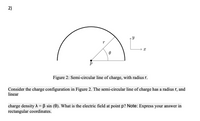Question

Transcribed Image Text:**Title: Understanding a Semi-Circular Line of Charge**
**Figure 2: Semi-Circular Line of Charge, with Radius \( r \)**
**Description:**
This figure illustrates a semi-circular line of charge with a radius \( r \). In the diagram, a semi-circle is centered at a point \( p \). The angle \( \theta \) is measured from the horizontal \( x \)-axis to the radius \( r \).
**Scenario:**
Consider the charge configuration shown in Figure 2. The semi-circular line of charge has a constant radius \( r \) and a linear charge density given by \( \lambda = \beta \sin(\theta) \), where \( \beta \) is a constant.
**Objective:**
Determine the electric field at point \( p \).
**Instructions:**
Calculate the electric field at point \( p \) due to the given charge distribution. Express your answer in rectangular coordinates (i.e., in terms of \( x \) and \( y \) components).
Expert Solution
This question has been solved!
Explore an expertly crafted, step-by-step solution for a thorough understanding of key concepts.
This is a popular solution
Trending nowThis is a popular solution!
Step by stepSolved in 2 steps with 2 images

Knowledge Booster
Similar questions
- A disk of radius r= 70 cm has a uniform surface charge densityo = 79.6 nC. Calculate the electric field ( in units of kN/C) at point P that lies along the central perpendicular axis of the disk and a distance 30 cm from the center of the disk. use ke = 9x109 N m²/C² Coloarrow_forwardA sphere of radius a is filled with a positive charge with uniform density p. Then a smaller sphere of radius a/2 is carved out leaving and empty cavity as shown in the drawing. What is the direction and magnitude of the electric field at point A? (Hint: Use superposition concepts) Select one: ρα Oa. E: = upward 360 Ob. It is not possible to calculate because there is no spherical symmetry. 2pa downward C. E: = 360 ρα O d. E= upward 660 ρα ○ e. E = downward 860 ○ f. 7pa E= upward 860arrow_forwardPictured below is a spherical conducting ball of radius a surrounded by a spherical non-conducting "thick" shell of inner radius b and outer radius c. The conducting ball has a total charge of Q1 and the non-conducting shell has a total charge of Q2 uniformly distributed throughout its volume (i.e., the volume charge density p for the shell is constant) a. Determine the volume charge density p of the non-conducting shell. b. Determine the electric field at a point a distance r from the center of the conducting ball. Consider separately each case: p < a, a C. c. If Q2 = - 2Q1, for which values of r is the electric field zero? Can you show all work part a b and carrow_forward
- At each point on the surface of the cube shown in the figure the electric field is parallel to the z axis. The length of each edge of the cube is 2.5 m. On the top face of the cube the electric field E 33 N/C and on the bottom face it is Ễ + 17k N/C . Determine the net charge contained within the cube. →> = -> = y Number i Unitsarrow_forward2. Find the electric field at a distance z above the center of a ring of radius a that has a uniform linear charge density A. Compute (only) the Er and Ez components of a cylindrical coordinate system.arrow_forwardA hollow metal sphere has 5 cm and 9 cm inner and outer radii, respectively, with a point charge at its center. The surface charge density on the inside surface is -150 nC/m². The surface charge density on the exterior surface is +150 nC/m² Part E What is the strength of the electric field at point 12 cm from the center? Express your answer to three significant figures and include the appropriate units. ► View Available Hint(s) E = Di μA Submit Xb a b X 10n Value Units You have already submitted this answer. Enter a new answer. No credit lost. Try again. Previous Answers ?arrow_forward
arrow_back_ios
arrow_forward_ios